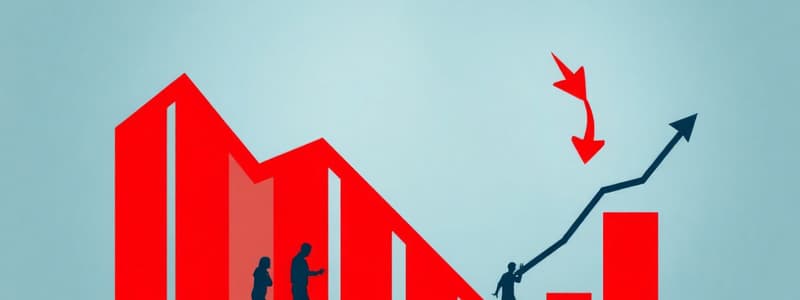Podcast
Questions and Answers
Which of the following best describes a 'trough' in the context of a business cycle?
Which of the following best describes a 'trough' in the context of a business cycle?
- The point where the economy stops contracting and begins to recover. (correct)
- A period of economic expansion and increasing employment.
- Two consecutive quarters of GDP decline.
- The peak of economic activity before a downturn.
If a country can produce a product using fewer resources than another country, this is known as what?
If a country can produce a product using fewer resources than another country, this is known as what?
- Competitive advantage
- Absolute advantage (correct)
- Opportunity cost
- Comparative advantage
Which economic indicator is most likely to provide insights into potential shifts in the economy?
Which economic indicator is most likely to provide insights into potential shifts in the economy?
- Lagging indicator
- Leading indicator (correct)
- Coincident indicator
- Marginal indicator
Assume a country can produce either 2,000 bushels of wheat or 3,000 bushels of corn with its available resources. What does this demonstrate?
Assume a country can produce either 2,000 bushels of wheat or 3,000 bushels of corn with its available resources. What does this demonstrate?
Which of the following is an example of a lagging economic indicator?
Which of the following is an example of a lagging economic indicator?
In the context of international trade, what does comparative advantage primarily refer to?
In the context of international trade, what does comparative advantage primarily refer to?
If a commuter chooses to take the train to work, which takes 70 minutes, instead of driving, which takes 40 minutes, what is the opportunity cost?
If a commuter chooses to take the train to work, which takes 70 minutes, instead of driving, which takes 40 minutes, what is the opportunity cost?
Assume the US has an absolute advantage in producing both Apples and Oranges. What condition is necessary for trade between the US and Canada?
Assume the US has an absolute advantage in producing both Apples and Oranges. What condition is necessary for trade between the US and Canada?
Which of the following best describes the relationship between absolute and comparative advantage?
Which of the following best describes the relationship between absolute and comparative advantage?
What characterizes the 'expansion' phase of a business cycle?
What characterizes the 'expansion' phase of a business cycle?
Which scenario describes the concept of opportunity cost?
Which scenario describes the concept of opportunity cost?
How would a deep trough in the business cycle be characterized?
How would a deep trough in the business cycle be characterized?
Both Canada and the US can produce apples and oranges. In Canada, it costs the equivalent of 0.5 oranges to produce one apple. In the US, it costs the equivalent of 0.67 oranges to produce one apple. Which country has the comparative advantage in producing apples?
Both Canada and the US can produce apples and oranges. In Canada, it costs the equivalent of 0.5 oranges to produce one apple. In the US, it costs the equivalent of 0.67 oranges to produce one apple. Which country has the comparative advantage in producing apples?
Both Canada and the US can produce apples and oranges. In Canada, it costs the equivalent of 2 apples to produce one orange. In the US, it costs the equivalent of 1.5 apples to produce one orange. Which country has the comparative advantage in producing oranges?
Both Canada and the US can produce apples and oranges. In Canada, it costs the equivalent of 2 apples to produce one orange. In the US, it costs the equivalent of 1.5 apples to produce one orange. Which country has the comparative advantage in producing oranges?
Which of the following is most accurate about absolute advantage?
Which of the following is most accurate about absolute advantage?
In economics, what is the primary difference between absolute advantage and comparative advantage?
In economics, what is the primary difference between absolute advantage and comparative advantage?
Which action represents a firm operating during a recession?
Which action represents a firm operating during a recession?
If one country has an absolute advantage in the production of all goods, can trade still be mutually beneficial?
If one country has an absolute advantage in the production of all goods, can trade still be mutually beneficial?
If a country currently produces both apples and oranges but decides to specialize in apple production, what will happen?
If a country currently produces both apples and oranges but decides to specialize in apple production, what will happen?
Which scenario best illustrates the concept of comparative advantage?
Which scenario best illustrates the concept of comparative advantage?
Flashcards
Business Cycle
Business Cycle
Recurring periods of increased and decreased economic activity, or expansions and contractions.
Recession
Recession
The economy slows down. There is a decline in consumer purchasing, an increase in unemployment, and businesses contract or close.
Trough
Trough
Bottom of the cycle; production and unemployment reach their lowest levels. The economy completes the recession and turns towards prosperity.
Expansion
Expansion
Signup and view all the flashcards
Peak
Peak
Signup and view all the flashcards
Leading Indicators
Leading Indicators
Signup and view all the flashcards
Lagging Indicators
Lagging Indicators
Signup and view all the flashcards
Coincident Indicators
Coincident Indicators
Signup and view all the flashcards
Absolute Advantage
Absolute Advantage
Signup and view all the flashcards
Opportunity Cost
Opportunity Cost
Signup and view all the flashcards
Comparative Advantage
Comparative Advantage
Signup and view all the flashcards
Study Notes
Business Cycle
- Economic activity experiences recurring periods of increase and decrease.
- Expansions and contractions are other terms to describe this activity.
- The economic cycle consists of recession, trough, expansion, and peak stages.
The Four Stages of the Economic Cycle
- Recession is characterized by a decline in GDP for two consecutive quarters, slowing the economy.
- Recession includes decreased consumer purchasing, increased unemployment, and business contraction or closure.
- Trough is the bottom of the cycle where production and unemployment are at their lowest.
- Trough indicates the economy is completing the recession and turning towards prosperity; a deep trough is called a depression.
- Expansion occurs when the economy starts to grow, employment increases, wages, production, and profits expand and new businesses arise with strong investment.
- Peak is the top of the business cycle, marking the end of expansion; the economy stops expanding and begins contracting.
- These stages repeat over time, creating the cyclical pattern of economies.
Economic Indicators
- Used to measure the economy's performance.
- Leading indicators adjust before the economy changes occur.
- Leading indicators help investors, businesses, and the government to act on potential changes, such as housing and retail sales.
- Lagging indicators adjust after the economy experiences a change and includes the employment rate.
- Coincident indicators move in conjunction with the business cycle, such as international trade or real wages.
Absolute Advantage
- Refers to a country's capability to produce a product more efficiently.
- Absolute advantage results in manufacturing more products using the same amount of resources.
- Absolute advantage is due to better technology, labor, or higher quality resources used.
- Zambia has an absolute advantage in making copper.
- Canada has an absolute advantage in making forest products.
Absolute Advantage Example
- If Canada can produce 1,000 apples with half of its resources and the United States can produce 1,400 oranges with half of its resources if each country specializes.
- Canada makes 2,000 apple by using all of its resources on apples, and the United States makes 2,800 oranges by using all of its resources on oranges.
Opportunity Cost
- Opportunity cost is defined as the value of the next-best alternative that a person gives up.
- Opportunity cost is not the value of all possible alternatives.
- As an example, the opportunity cost of a student who spends three hours and $20 at the movies the night before an exam, or a farmer who chooses to plant wheat
- Or a commuter takes the train to work instead of driving, costing 70 minutes instead of 40.
Opportunity Cost Example
- Canada has an absolute advantage in producing apples, whereas the U.S. has an absolute advantage in producing oranges.
- If Canada specializes in apples it gives up 600 oranges.
- If the U.S. specializes in oranges, it gives up 800 apples.
Comparative Advantage
- Comparative advantage occurs when a country can produce a good at a lower opportunity cost than another country.
- Comparative advantage is the basis for specialization and trade.
- Countries do not have to have an absolute advantage to engage in trade: they only need a comparative advantage.
- Assume that United States has an absolute advantage in producing both apples and oranges and they both spend an equal amount of time producing different products.
Comparative Advantage Example
- In Canada, 1,000 apples equals 500 oranges, so one apple costs 0.5 oranges.
- In the U.S., 1,200 apples equals 800 oranges, so one apple costs 0.667 oranges.
- The opportunity cost of giving up oranges to produce apples is lower in Canada, so Canada should only produce apples.
Comparative Advantage Example
- In Canada, 1,000 apples equals 500 oranges, so one orange costs 2 apples.
- In the U.S., 1,200 apples equals 800 oranges, so one orange costs 1.5 apples.
- The opportunity cost of giving up apples to produce oranges is lower in the U.S., so the U.S. should only produce oranges.
- Even if the United States can produce more apples and oranges, Canada has a comparative advantage in producing apples because it has a lower opportunity cost.
Comparative Advantage Continued
- Canada focuses on apples and the United States focuses on oranges, the level of production increases.
- If United States specializes and focuses on producing oranges they can produce 1,600 oranges.
- If Canada specializes and focuses on producing apples they can produce 2,000 apples
- Production in both countries can be adjusted so no apples are lost (back to original level of 2200 apples). 200 apples = 200 *.667 oranges = 133 oranges lost (to make 200 apples, the countries would give up 133 oranges). 1600 oranges – 133 oranges = 1,467 oranges.
Studying That Suits You
Use AI to generate personalized quizzes and flashcards to suit your learning preferences.



